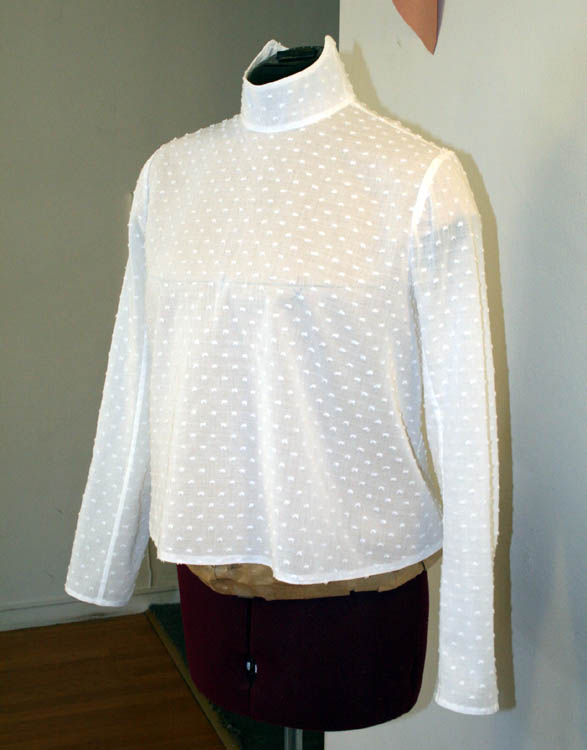
February – August 2012
A bolero jacket to match my wool crepe walking skirt. This jacket was originally meant to be a trial version. I’ve made several attempts at Edwardian jackets over the past few years, so wasn’t holding my breath. In fact, this was the second bolero cut from this wool. But the construction went smoothly the second time around and I ended up finishing it inside and out. Good thing I bought two extra yards.
In these photos the jacket is worn with both a guimpe and an eyelet blouse, which I’ve described separately below. Also pictured is a dip-waist belt described on the 20th Century Accessories page, and some short leather vintage gloves.
Bolero jacket (February – August 2012)
The jacket is underlined in silk organza, taped, and bag-lined in china silk. It’s topstitched all around to match the skirt. The sleeve linings were put in by hand, as described in the Roberto Cabrera tailoring book. The collar was added as an afterthought in January 2015 so it’s simply basted on. However it doesn’t want to sit right on the neckline so it’s offset in this way. But I like it all the same. The jacket itself tends to slip backwards, so after taking the first set of photos I added blue petersham ties to the neckline. This really helps anchor it.


The pattern is Truly Victorian’s #498, 1898 Eton Jacket. Sleeves and cuffs are from the 1906-07 bolero in The Cut of Women’s Clothes (diagram LXIV). And these cuffs still have me completely stumped. I puzzled for weeks over different methods of attaching them. It’s hard to tell from the line drawing if the full width of the cuff shows, or if its a turn-back cuff. The proportions seem to show the full width facing, but the trim placement indicates it’s turned. The heavily gathered sleeve creates too much bulk to press it along the seam. And I wanted a wide cuff. So in my mock-up, I had the cuff rolling tightly over the gathered sleeve end, like a bias binding. It seemed to be a good solution, and I was going to topstitch it in place. But in the final version, the topstitching over all that bulk looked terrible. So I simply made turned-back cuffs. They’re pressed 3/4″ from the wrist seam.
It also occurred to me that the sleeves could be sewn to a simple band, which would then attach to the cuff. There’s a description of this here, page 419, for a “Ladies Blouse Jacket.” The pattern in The Cut of Women’s Clothes doesn’t show a band piece, but it might be worth trying.
You can get an idea of just how full the sleeves are from the inside out view, as I used the same pattern for the sleeve linings.
Guimpe (October – November 2008)
A guimpe in cotton dotted Swiss, with 3/8″ shell buttons for the back closure. The pattern is from Laughing Moon’s #104, “1909-13 Day & Evening Dress.” I decided to include this blouse with the undies as it’s meant to be worn under a dress or over-blouse, and not by itself.


The pattern was made up without any adjustments. Despite my relatively square shoulders, the collar and neckline are pretty good. I normally lengthen the armscye on LM patterns (and, as might be expected, it’s a bit tight under the arms).
My usual finishing methods were all used: french seams, an edgestitched hem and binding of the armscye. Collar wires from Farthingales are sewn to the outside of the collar’s lining. After the first wearing, I made tiny 1/4″ covers for them out of batiste, as my hair was getting tangled and caught in the loops!
Eyelet Blouse (October – December 2014)
Despite my little collection of Edwardian blouses, I wanted something slightly different to wear under the 1906 bolero. There was just enough cotton eyelet left from my 1905 Everyday outfit’s blouse to make a simple guimpe. The pattern is Laughing Moon’s #104, which is meant to be worn under a dress and fits snugly. So I went up a size and lengthened it several inches. The sleeves seemed to be restricting my range of motion so I finished it as a sleeveless blouse. But four years later I wanted sleeves after all. They were still in my stash, all sewn up, and I couldn’t find any real reason not to add them. Maybe I’m just less fussy now. The blouse closes up the back with pretty shell buttons. I rarely bother to photograph the backs of garments as fitted necklines won’t close over this dressform.
As the blouse has 3/4 length sleeves I whipped up a pair of separate half sleeves which extends them.



